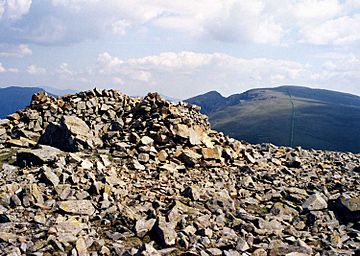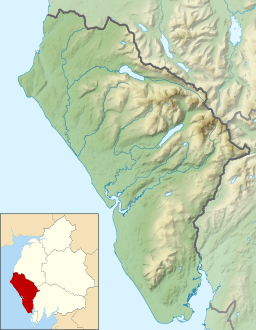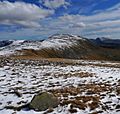Haycock (Lake District) facts for kids
Quick facts for kids Haycock |
|
|---|---|

The stony summit of Haycock with Scoat Fell and Steeple in the distance
|
|
| Highest point | |
| Elevation | 797 m (2,615 ft) |
| Prominence | c.94 m (308 ft) |
| Parent peak | Pillar |
| Listing | Hewitt, Nuttall, Wainwright |
| Geography | |
| Location | Cumbria, England |
| Parent range | Lake District, Western Fells |
| OS grid | NY144107 |
| Topo map | OS Landranger 89, Explorer OL4 |
| Listed summits of Haycock (Lake District) | ||||
| Name | Grid ref | Height | Status | |
|---|---|---|---|---|
| Little Gowder Crag | NY140109 | 733 m (2,404 ft) | Nuttall | |
Haycock is a mountain in the western part of England's beautiful Lake District. It stands tall between Scoat Fell and Caw Fell. You can find it south of Ennerdale and north of Wasdale. Haycock is a big, dome-shaped mountain. It's a bit far away, so not as many people visit it. But if you do, you'll find amazing views of the other mountains.
Contents
Where is Haycock?
The Western Fells are a group of mountains in the Lake District. They form a triangle shape. Haycock is part of this group. These mountains create a big horseshoe shape around the long, wild Ennerdale Valley. Haycock is on the southern side of this horseshoe.
The main line of mountains goes west from Great Gable. It separates the rivers that flow into Ennerdale and Wasdale. As you go west, you'll see big mountains like Kirk Fell, Pillar, Scoat Fell, Haycock, and Caw Fell. Haycock also has a ridge that goes south to another mountain called Seatallan.
Interesting Features
On Haycock's northern side, there are steep rocks that drop into a place called Great Cove. A stream called Deep Gill starts here. It flows down through a forest into Ennerdale, near the lake.
North-west of the top of Haycock, there's a smaller peak called Little Gowder Crag. It's listed as a Nuttall, which is a type of mountain. It looks like a rocky "knuckle" when you see it from the north.
Haycock's southern slopes are split by the ridge that goes to Seatallan and Middle Fell. Rivers like the Bleng and Nether Beck flow from these slopes. The River Bleng eventually joins the River Irt and flows into the sea at Ravenglass. Nether Beck goes straight towards Wast Water.
What is Haycock Made Of?
The top of Haycock is made of a type of volcanic rock called andesite. This rock was formed from ancient lava flows. Below this, you can find layers of siltstone, sandstone, and tuff. These are rocks made from tiny bits of sediment and ash. There are also areas of dacite rock nearby.
The Summit Views
There's a wall called the Ennerdale Fence that runs along the top of Haycock. It crosses the very top of the mountain. You'll find a pile of stones, called a cairn, on both sides of the wall. The one on the north side is usually seen as the highest point. The whole top area is very rocky. There's another cairn to the south that offers a great viewpoint.
Even though Haycock is a bit far from the center of the Lake District, the views from the top are fantastic! You can see the famous Scafells from the side. On clear days, you might even spot Helvellyn and Skiddaw in the distance. You can see Ennerdale Water from the very top. If you walk to the southern cairn, you'll get a good view of Wast Water.
How to Climb Haycock
There are a few ways to climb Haycock. From Ennerdale, you can follow a path that goes up a ridge next to Deep Gill. Another longer path goes up a different ridge called Tewit How.
If you're coming from Wast Water, you can start near Netherbeck Bridge. You follow the stream around the base of Middle Fell. Once you reach Ladcrag Beck, you can take a more direct path up Haycock. Another option from below the lake is to follow the Greendale Beck valley.
You can also climb Haycock after visiting other nearby mountains. Many walkers climb Seatallan, Middle Fell, or Scoat Fell first, then continue to Haycock.
Images for kids





